
- Home
- Travel Packages
- Top Destination
-
Travel Attraction
By Category
Top Attraction

- Travel Agents
- Car Rentals
- Hotels
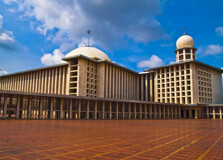
The Istiqlal Mosque, located in Jakarta, Indonesia, is the largest mosque in Southeast Asia and the national mosque of Indonesia. Its name, Istiqlal, means "independence" in Arabic, symbolizing Indonesia's struggle for independence from Dutch colonization. The mosque was designed by Frederich Silaban, a Christian architect, and was inaugurated in 1978 by Indonesia's second president, Soeharto. Architecture of Istiqlal Mosque The architecture of the Istiqlal Mosque is a blend of modern and traditional styles, with a large dome at the center and a minaret on each side. The mosque can accommodate over 120,000 worshippers and features a spacious prayer hall, ablution fountains, and Islamic calligraphy adorning the walls. The interior is decorated with marble and stained glass windows, creating a serene and contemplative atmosphere for prayer and reflection. History The construction of the Istiqlal Mosque was initiated in 1961 by Indonesia's first president, Sukarno, as a symbol of national pride and unity. The mosque was built to commemorate Indonesia's independence from Dutch rule and to provide a place of worship for the growing Muslim population in Jakarta. The project faced challenges due to lack of funding and political turmoil, but it was eventually completed and inaugurated in 1978. Best Time To Visit The best time to visit the Istiqlal Mosque is during the holy month of Ramadan, when the mosque is filled with worshippers and special prayers and events are held to mark the occasion. Visitors can experience the vibrant atmosphere of Ramadan, participate in iftar (breaking the fast) gatherings, and witness the devoutness of the Muslim community. It is also recommended to visit the mosque during weekdays to avoid the crowds that gather on weekends. How To Reach The Istiqlal Mosque is located in central Jakarta, near Merdeka Square and the Jakarta Cathedral. Visitors can reach the mosque by various means of transportation, including public buses, taxis, and online ride-hailing services. The mosque is easily accessible from different parts of the city, and there are designated parking areas for those who prefer to drive. It is advisable to check the traffic conditions in advance to plan your visit accordingly. Visitor Tips 1. Dress modestly when visiting the Istiqlal Mosque, covering your arms and legs out of respect for the Muslim tradition. 2. Remove your shoes before entering the mosque and make sure to maintain silence and respect during prayers. 3. Take the time to explore the mosque's architecture and design, as well as the beautiful views of Jakarta from the top of the minarets. 4. Visit the mosque in the early morning or late afternoon to avoid the heat and humidity of Jakarta's tropical climate. 5. Consider joining a guided tour of the mosque to learn more about its history, significance, and cultural importance.
Explore More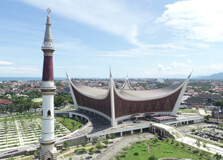
The Raya Mosque, also known as Masjid Raya, is a historic mosque located in the heart of the bustling city of Medan in North Sumatra, Indonesia. This mosque holds significant cultural and religious importance to the local Muslim community and is a popular tourist attraction for visitors looking to explore the rich history and architecture of the region. Architecture of Raya Mosque The Raya Mosque is a stunning example of traditional Indonesian Islamic architecture, featuring intricate geometric patterns, ornate calligraphy, and elegant domes. The mosque's towering minarets and large prayer hall are awe-inspiring, and the interior is adorned with beautiful stained glass windows and elaborate tilework. The overall design of the mosque reflects a blend of Middle Eastern, Indian, and local Sumatran influences, creating a unique and visually striking structure. History The Raya Mosque was originally built in 1906 during the Dutch colonial period, making it one of the oldest mosques in Medan. Over the years, the mosque has undergone several renovations and expansions, with the most recent restoration taking place in the 1990s. Despite these changes, the Raya Mosque has retained its original charm and continues to serve as a place of worship for the local Muslim community. Best Time To Visit The best time to visit the Raya Mosque is during the early morning hours or late afternoon when the light is soft and the temperatures are cooler. The mosque is open to visitors throughout the day, but it's recommended to avoid peak prayer times to respect the worshippers and maintain a peaceful atmosphere. Additionally, visiting during Ramadan or other Islamic holidays can provide a unique cultural experience and a chance to witness special ceremonies and traditions. How To Reach The Raya Mosque is conveniently located in the center of Medan, making it easily accessible by public transportation or taxi. Visitors can also take a leisurely stroll through the city streets to reach the mosque, enjoying the bustling markets and vibrant atmosphere along the way. For those coming from outside Medan, the city is well-connected by air, rail, and road, with several transportation options available to reach the mosque. Visitor Tips - Remember to dress modestly when visiting the mosque, covering your shoulders and knees out of respect for the religious customs. - Remove your shoes before entering the mosque and follow any specific guidelines given by the staff or local worshippers. - Avoid visiting the mosque during prayer times, as it can disrupt the peaceful atmosphere and prevent worshippers from focusing on their prayers. - Take time to explore the surrounding area, including the historic streets of Medan and nearby markets, to fully appreciate the cultural heritage of the region. - Consider hiring a local guide to learn more about the history and significance of the Raya Mosque, as well as other attractions in Medan and North Sumatra.
Explore More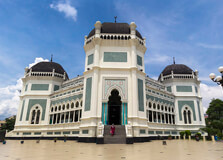
Mesjid Raya Al-Mashun, or the Great Mosque of Medan, stands as a magnificent symbol of Islamic faith and a significant landmark in the heart of Medan, the capital city of North Sumatra, Indonesia. Its grandeur and unique architectural blend attract not only worshippers but also tourists and history enthusiasts from across the globe. This detailed guide will explore various aspects of this iconic mosque, providing essential information for anyone interested in visiting or learning more about it. How to reach Mesjid Raya Mosque, Medan Reaching Mesjid Raya Mosque in Medan is relatively straightforward due to its central location. Here are several ways to get there: By Car or Motorcycle: If you have your own vehicle or rent one, you can easily navigate to the mosque using GPS or local maps. The mosque is located on Jalan Sisingamangaraja, a major thoroughfare in Medan. Parking is usually available around the mosque area, though it might get crowded during prayer times and weekends. By Public Transportation (Angkot): Medan has a network of minibuses known as "angkot." Several angkot routes pass through or near Jalan Sisingamangaraja. You can ask locals for the specific route that goes to Mesjid Raya. By Becak or Taxi: Traditional Indonesian trishaws (becak) and taxis are readily available in Medan. You can hire a becak for a more local experience, especially for shorter distances. Taxis are also a convenient option, and ride-hailing apps are increasingly popular in the city. By Trans Mebidang Bus: Medan has a bus rapid transit system called Trans Mebidang. Check the routes to see if any of the corridors have a stop near the mosque. Walking: If your accommodation is located centrally, you might be able to walk to the mosque, especially if you enjoy exploring the city on foot. Weather in Medan Medan experiences a tropical rainforest climate, characterized by high temperatures and humidity throughout the year. Rainfall is common, with two main rainy seasons: one typically from March to May and another from September to November. The average daily temperature in Medan ranges from 25°C to 32°C (77°F to 90°F). It's advisable to be prepared for hot and humid conditions and occasional rain showers when visiting Medan and the mosque. Timing (Opening Hours) As a place of worship, Mesjid Raya Mosque is generally open to visitors outside of prayer times. However, it's important to be respectful of worshippers and avoid visiting during congregational prayers. While specific opening hours for tourists might not be formally published, it's generally acceptable to visit between 9:00 AM and 5:00 PM on weekdays and Saturdays. It is best to avoid visiting during the main prayer times (five times a day) and especially on Fridays during the Friday prayer (usually around noon to 1:30 PM). Sundays might also see higher visitor traffic. It's always a good idea to dress modestly and respectfully when visiting the mosque. Why famous for Mesjid Raya Mosque, Medan? Mesjid Raya Mosque is famous for several reasons: Historical Significance: It is one of the oldest and most historically significant mosques in Medan, having been completed in 1909. Architectural Beauty: The mosque boasts a unique and stunning architectural style that blends Middle Eastern, Indian, and Spanish influences. Its octagonal shape and intricate ornamentation are particularly noteworthy. Landmark Status: It serves as a prominent landmark in Medan and is a symbol of the city's rich cultural and religious heritage. Part of Maimun Palace Complex: Initially, the mosque was part of the larger Maimun Palace complex, the royal palace of the Deli Sultanate, adding to its historical importance. Spiritual Center: It remains an active and important center for Islamic worship in Medan, attracting a large number of devotees. Entry and Visit Details about Mesjid Raya Mosque, Medan Visiting Mesjid Raya Mosque is generally free of charge, but donations are welcome for the upkeep and maintenance of the mosque. Here are some important details for your visit: Dress Code: Visitors are required to dress modestly. Both men and women should cover their shoulders and knees. Women are also advised to cover their heads, and headscarves are often available for loan at the mosque. Footwear: You will need to remove your shoes before entering the main prayer hall. There are designated areas for storing footwear. Photography: Photography is generally allowed in the mosque compound, but it's crucial to be respectful and avoid taking pictures during prayer times or in a way that might disturb worshippers. Always ask for permission before photographing individuals. Conduct: Maintain a respectful and quiet demeanor inside the mosque. Avoid loud conversations, eating, or drinking within the prayer areas. Guided Tours: While formal guided tours might not always be available, you can often find local guides around the mosque who can offer insights into its history and architecture. It's advisable to negotiate the price beforehand. Best Time to Visit: The best time to visit is generally outside of prayer times. Early mornings or late afternoons are usually less crowded and offer better lighting for photography. History The construction of Mesjid Raya Al-Mashun began in 1906 and was completed in 1909 during the reign of Sultan Ma'moen Al Rasyid Perkasa Alam of the Deli Sultanate. The mosque was envisioned as a grand and majestic place of worship that would reflect the power and prestige of the sultanate. It was designed by a Dutch architect, Van Erp, who also contributed to the design of the Maimun Palace. The mosque was initially part of the Maimun Palace complex, highlighting the close relationship between the religious and royal authorities of the time. Over the years, the mosque has undergone some renovations and expansions to accommodate the growing number of worshippers, but it has largely retained its original architectural design and historical significance. Architecture The architecture of Mesjid Raya Mosque is a captivating blend of several styles, primarily Moorish, Middle Eastern, Indian, and to some extent, Spanish influences. Key architectural features include: Octagonal Shape: The main building of the mosque has an octagonal shape, which is quite unique for mosques in Indonesia. Domes: The mosque is adorned with several domes, including a large central dome and smaller domes over the wings. These domes exhibit a distinctive Moorish design. Minarets: Two towering minarets flank the main entrance, showcasing a blend of Middle Eastern and Indian architectural elements. Arches and Columns: Intricate arches and sturdy columns support the structure, reflecting Islamic architectural traditions. Ornamentation: The mosque is richly ornamented with decorative carvings, floral motifs, and Islamic calligraphy, adding to its aesthetic appeal. Wings: The mosque has wings extending to the south, east, north, and west, providing additional prayer spaces. Materials: The construction utilized high-quality materials, including granite from China and marble from Italy, reflecting the grandeur intended by the sultanate. Things to do Besides offering prayers, there are several things visitors can do at and around Mesjid Raya Mosque: Admire the Architecture: Take your time to appreciate the unique blend of architectural styles and the intricate details of the mosque's design. Learn about the History: Explore the historical significance of the mosque and its connection to the Deli Sultanate. You can often find information plaques or local guides who can share insights. Observe Prayer Times (Respectfully): If you are interested in witnessing Islamic prayers, you can respectfully observe from a distance outside the main prayer hall. Visit Maimun Palace: Located nearby, the Maimun Palace is another historical landmark worth visiting to understand the context of the mosque's origin. Explore the Surrounding Area: The area around the mosque is bustling with local markets and shops where you can experience the local culture and cuisine. Take Photographs: Capture the beauty of the mosque's architecture, but remember to be respectful and mindful of worshippers. Facts about Mesjid Raya Mosque, Medan Here are some interesting facts about Mesjid Raya Mosque: The construction cost was reportedly around one million Dutch guilders, a significant sum at the time. The mosque can accommodate approximately 2,000 worshippers. The architect, Van Erp, also oversaw the archaeological restoration of Borobudur Temple in Central Java. The mosque has been a symbol of Medan for over a century and has witnessed significant historical events. The blend of architectural styles reflects the diverse cultural influences present in Medan during the early 20th century. Tips about Mesjid Raya Mosque, Medan To make your visit to Mesjid Raya Mosque more enjoyable and respectful, consider these tips: Dress Appropriately: Ensure you are dressed modestly before arriving at the mosque. Be Mindful of Prayer Times: Avoid visiting during prayer times to minimize disturbance to worshippers. Remove Shoes: Remember to take off your shoes before entering the prayer hall. Be Respectful: Maintain a quiet and respectful demeanor throughout your visit. Ask for Permission Before Photographing People: Always be considerate when taking pictures. Carry Small Change: Donations are appreciated for the mosque's upkeep. Stay Hydrated: Medan can be hot and humid, so carry water, especially if you are visiting during the day. Learn Basic Indonesian Phrases: Knowing a few basic phrases can enhance your interaction with locals. Check for Local Events: Be aware of any special religious events or holidays that might affect visiting hours or accessibility. Mesjid Raya Mosque in Medan is more than just a place of worship; it is a testament to history, art, and cultural fusion. A visit to this magnificent mosque offers a glimpse into Medan's rich heritage and the beauty of Islamic architecture.
Explore More
Masjid Al Akbar, also known as the Grand Mosque of Surabaya, is one of the largest mosques in Indonesia. Located in the heart of Surabaya, this mosque is a significant religious, cultural, and architectural landmark. Its striking blue dome and towering minaret make it an iconic sight in the city. How to Reach Masjid Al Akbar, Surabaya The mosque is located in South Surabaya, making it accessible by various means of transportation: By Car or Motorcycle: Visitors can drive to the mosque, which has a large parking area. By Public Transport: City buses and angkot (shared minivans) pass by the area, making it convenient for travelers. By Ride-Hailing Services: Apps like Gojek and Grab offer easy transport options directly to the mosque. Weather in Masjid Al Akbar, Surabaya Surabaya has a tropical climate, with temperatures ranging from 26°C to 34°C (79°F to 93°F). The best time to visit is during the dry season (May to September), as the rainy season (October to April) may bring occasional heavy showers. Timing and Best Time to Visit The mosque is open daily for prayers and visitors. The best time to visit is during non-prayer hours to explore the architecture peacefully. However, attending a prayer session can be a spiritually enriching experience. Why is Masjid Al Akbar Famous? Masjid Al Akbar is famous for its grandeur and architectural beauty. It features one of the largest domes in Indonesia, an impressive minaret, and intricate Islamic calligraphy. The mosque is a significant religious center, attracting both worshippers and tourists. Entry and Visit Details Visitors should be aware of the following guidelines: Entry Fee: Free for general visits, but a small fee may apply for access to the minaret. Dress Code: Modest clothing is required; women should wear headscarves. Photography: Allowed in most areas, but respect should be maintained. History and Architecture Masjid Al Akbar was inaugurated in 2000 as part of Surabaya's development as a modern Islamic hub. The mosque showcases a blend of traditional and contemporary Islamic architecture, featuring a massive blue dome, tall minarets, and detailed ornamentation. Things to Do at Masjid Al Akbar Visitors can engage in several activities: Explore the Architecture: Admire the grand dome, intricate calligraphy, and beautiful prayer hall. Visit the Minaret: Take an elevator to the top for panoramic views of Surabaya. Attend a Prayer Session: Experience the spiritual ambiance of a large congregation. Shop for Souvenirs: Islamic books and traditional items are available nearby. Interesting Facts and Tips Facts: Masjid Al Akbar is the second-largest mosque in Indonesia. The main dome is supported by 45-meter-high pillars. The mosque can accommodate up to 59,000 worshippers. Tips: Visit early in the morning or late in the afternoon to avoid the heat. Respect the prayer schedule and maintain silence inside the mosque. If visiting the minaret, bring a camera for breathtaking city views.
Explore More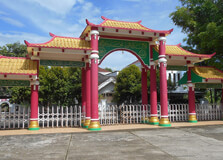
Cheng Ho Mosque, also known as Masjid Muhammad Cheng Hoo, is a unique religious landmark in Surabaya. It stands out for its Chinese-style architecture, which pays tribute to Admiral Cheng Ho, a Chinese-Muslim explorer who played a significant role in spreading Islam in Indonesia. This mosque serves as both a place of worship and a symbol of cultural harmony. How to Reach Cheng Ho Mosque, Surabaya Cheng Ho Mosque is located in the heart of Surabaya, making it easily accessible by various transportation modes: By Car or Motorcycle: The mosque is centrally located, and there is parking available nearby. By Public Transport: City buses and angkot (shared minivans) pass through the area, offering easy access. By Ride-Hailing Services: Apps like Gojek and Grab provide convenient transport options directly to the mosque. Weather in Cheng Ho Mosque, Surabaya Surabaya experiences a tropical climate with temperatures ranging from 26°C to 34°C (79°F to 93°F). The best time to visit is during the dry season (May to September), as the rainy season (October to April) may bring occasional heavy showers. Timing and Best Time to Visit The mosque is open daily for prayers and visitors. The best time to visit is during non-prayer hours for a peaceful experience. Fridays tend to be busier due to the congregational prayers. Why is Cheng Ho Mosque Famous? Cheng Ho Mosque is famous for its distinctive Chinese-style architecture, which is rare for a mosque. It represents the integration of Islamic and Chinese cultures and serves as a reminder of Admiral Cheng Ho’s contributions to Indonesia’s history. Entry and Visit Details Visitors should follow these guidelines: Entry Fee: Free for all visitors. Dress Code: Modest attire is required, with women advised to wear a headscarf. Photography: Allowed in most areas, but visitors should be respectful. History and Architecture Cheng Ho Mosque was built in 2002 by the Indonesian-Chinese Muslim Association. The mosque’s architecture resembles a Chinese pagoda, featuring red and green colors, curved roofs, and intricate carvings that blend Islamic and Chinese artistic styles. Things to Do at Cheng Ho Mosque Visitors can enjoy several activities: Explore the Architecture: Admire the fusion of Islamic and Chinese design elements. Learn About Cheng Ho: Discover the history of Admiral Cheng Ho and his voyages. Attend a Prayer Session: Experience the spiritual ambiance of the mosque. Visit Nearby Attractions: Explore other cultural and historical sites in Surabaya. Interesting Facts and Tips Facts: Cheng Ho Mosque was the first mosque in Indonesia to incorporate Chinese-style architecture. The mosque was inspired by the architectural style of temples in China. It was built to honor Admiral Cheng Ho, a Muslim explorer who traveled to Indonesia in the 15th century. Tips: Visit in the morning or late afternoon to avoid the heat. Respect the prayer schedule and maintain silence inside the mosque. Take time to appreciate the cultural and historical significance of the mosque.
Explore More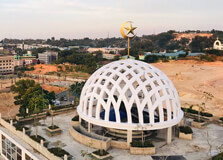
The Jabal Arafah Mosque is one of Batam's most prominent and beautiful places of worship. Located in the heart of the island, this mosque stands out not only for its religious significance but also for its stunning architecture and serene atmosphere. The mosque attracts both locals and tourists who come to admire its grandeur and its spiritual importance. With its towering minarets and vast prayer hall, the mosque is a symbol of faith and unity for the Muslim community in Batam and beyond. How to Reach Jabal Arafah Mosque, Batam Getting to the Jabal Arafah Mosque is quite easy, thanks to its central location in Batam. The mosque is situated in the central district of Batam, close to many key landmarks, making it accessible from various parts of the island. From Batam Center or the ferry terminal, the mosque is about a 20-minute drive, depending on traffic conditions. If you are arriving from the Batam Center Ferry Terminal, you can take a taxi or use ride-hailing apps like Grab to reach the mosque comfortably. The roads are well-maintained, and there are clear signs directing you towards the mosque. For those who prefer public transport, local buses are available, but it may take longer and be less direct than taking a taxi or private car. Weather at Jabal Arafah Mosque, Batam Batam enjoys a tropical climate, which means it is hot and humid year-round. The average temperature typically ranges between 25°C (77°F) to 32°C (90°F). The city experiences a distinct wet season and dry season. The wet season usually lasts from November to March, with occasional heavy rains, while the dry season occurs from April to October and is generally more pleasant for outdoor activities. When visiting the Jabal Arafah Mosque, it is advisable to plan your visit during the dry season to avoid discomfort from the heat and rain. However, since the mosque is an indoor place of worship, you can always visit it regardless of the weather outside. The air-conditioning inside the mosque helps to provide a comfortable environment for visitors and worshippers. Timing for Visiting Jabal Arafah Mosque, Batam The Jabal Arafah Mosque is open to visitors throughout the day, but it is primarily a place of worship, so it is best to visit during non-prayer times to fully appreciate the mosque's beauty and serenity. The mosque is open for prayers five times a day: Fajr (dawn), Dhuhr (midday), Asr (afternoon), Maghrib (sunset), and Isha (night). If you are visiting during these times, you should be respectful of the mosque's religious practices. The mosque is particularly busy during prayer times, with many worshippers attending the daily congregational prayers. If you wish to visit as a tourist and avoid the crowds, it is best to go during off-peak hours, such as mid-morning or early afternoon. The mosque is also a peaceful place to visit during the evening hours when the surrounding area is calm. Why Famous for Jabal Arafah Mosque, Batam? The Jabal Arafah Mosque is famous for several reasons. Firstly, it is one of the largest mosques in Batam and serves as a central place of worship for the local Muslim community. The mosque’s impressive architecture, which features traditional Islamic designs and modern elements, draws visitors and admirers from across the island. It is also an important religious site for the residents of Batam, especially during Islamic holidays and events. Secondly, the mosque’s name, "Jabal Arafah," holds significant meaning in Islamic tradition. Jabal Arafah is the name of a mountain in Saudi Arabia where pilgrims gather during the annual Hajj pilgrimage, making the mosque’s name a symbol of spirituality and connection to the Islamic world. Lastly, the mosque is famous for its beautiful and peaceful environment. The large prayer hall, serene surroundings, and calming atmosphere make it a popular place for both worshippers and tourists seeking a quiet space for reflection and spiritual peace. Entry and Visit Details for Jabal Arafah Mosque, Batam Visitors to the Jabal Arafah Mosque are welcome to explore the mosque and its surroundings, although it is primarily a place of worship. There is no entry fee to visit the mosque, and it is open to all, regardless of religious background. However, visitors are expected to show respect for the religious significance of the place. It is important to note that modest attire is required when entering the mosque. Both men and women should cover their shoulders and knees, and women may be required to wear a headscarf when inside the prayer hall. Visitors are also encouraged to remove their shoes before entering the mosque's main building. The mosque is open for prayers throughout the day, so it is advisable to visit during non-prayer hours if you want to explore the mosque more leisurely. If you are visiting for prayer, it is customary to follow the appropriate etiquette, such as praying quietly and refraining from disturbing others. History and Architecture of Jabal Arafah Mosque The Jabal Arafah Mosque was built to cater to the growing Muslim population in Batam. It was designed with a combination of traditional Islamic and modern architectural styles, making it an important landmark in the region. The mosque's design features beautiful arches, domes, and a towering minaret, which are typical elements of Islamic architecture. One of the most striking features of the mosque is its large, open prayer hall that can accommodate hundreds of worshippers. The hall is beautifully decorated with intricate calligraphy and patterns that represent Islamic art and culture. The mosque is surrounded by gardens and green spaces, adding to its peaceful and serene atmosphere. Over the years, the mosque has become a symbol of unity and spirituality for the people of Batam. It has also been a focal point for various religious and cultural events, including religious celebrations and community gatherings. Things to Do at Jabal Arafah Mosque Although the Jabal Arafah Mosque is primarily a place of worship, there are several activities you can enjoy during your visit: Photography: The mosque’s stunning architecture makes it a great place for photography. Visitors can take photos of the exterior, the prayer hall, and the surrounding gardens. Religious Reflection: If you are a Muslim, you can join the congregational prayers held five times a day. It is a peaceful and spiritual experience to pray in such a serene environment. Exploration: Walk around the mosque’s grounds and explore the surrounding gardens. It’s a great way to enjoy the quiet and peaceful atmosphere. Learn About Islam: The mosque provides an opportunity to learn more about Islamic culture and the local Muslim community. Visitors can speak with the mosque's staff or other worshippers to gain a deeper understanding of Islamic practices. Interesting Facts About Jabal Arafah Mosque The mosque is named after Mount Arafah in Saudi Arabia, where millions of Muslims gather during the Hajj pilgrimage. The Jabal Arafah Mosque is one of the largest mosques in Batam and serves as an important religious and cultural center for the island's Muslim population. The mosque’s architecture blends traditional Islamic elements with modern design, featuring a large prayer hall, intricate decorations, and a towering minaret. It hosts regular religious events and celebrations, especially during important Islamic holidays such as Eid al-Fitr and Eid al-Adha. Tips for Visiting Jabal Arafah Mosque Dress modestly, as it is a place of worship. Women should consider bringing a headscarf to cover their hair when entering the mosque. Respect the mosque’s religious practices and be mindful of worshippers during prayer times. If you plan to take photographs, be sure to ask permission first, especially inside the prayer hall. Visit during non-prayer hours for a more relaxed and less crowded experience. Take the time to learn about the mosque’s history and significance by speaking with the staff or reading informative materials available at the mosque.
Explore More